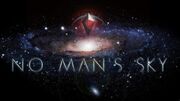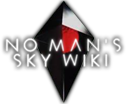Ddfairchildd (talk | contribs) (updated references to crossplay) |
Ddfairchildd (talk | contribs) |
||
| (11 intermediate revisions by 5 users not shown) | |||
| Line 1: | Line 1: | ||
| − | {{Version| |
+ | {{Version|Expeditions}} |
| − | {{stub}} |
||
[[File:nmsMisc_Universe.jpg|thumb]] |
[[File:nmsMisc_Universe.jpg|thumb]] |
||
The '''universe''' is the largest named object in No Man's Sky. |
The '''universe''' is the largest named object in No Man's Sky. |
||
==Summary== |
==Summary== |
||
| − | The |
+ | The [[universe]] of [[No Man's Sky]] comprises 255 unique [[galaxy|galaxies]]. In turn, these are composed of: |
| + | * 4.2 billion [[region]]s (the limit of a 32 bit integer) |
||
| + | * each of which contain more than 122 and up to roughly 580 [[star system]]s |
||
| + | |||
| + | All star systems feature from 2-6 [[planet]]s and [[moon]]s, and usually a single [[space station]]. |
||
| + | |||
| + | There are about 18 quintillion possibilities (seeds) for planets (the limit of a 64 bit integer). |
||
==Permutation== |
==Permutation== |
||
| Line 77: | Line 82: | ||
* [[Visions]] - The universe experienced a limited regeneration by the addition of new [[Biome - Exotic|exotic biomes]]. |
* [[Visions]] - The universe experienced a limited regeneration by the addition of new [[Biome - Exotic|exotic biomes]]. |
||
* [[Beyond]] - The universe experienced a limited regeneration by converting [[Biome - Dead|Dead biomes]] into Exotic ones due to a [[Biome#Convert Dead To Weird|coded property]]. |
* [[Beyond]] - The universe experienced a limited regeneration by converting [[Biome - Dead|Dead biomes]] into Exotic ones due to a [[Biome#Convert Dead To Weird|coded property]]. |
||
| − | * [[ |
+ | * [[Crossplay]] - removed the crossplay restriction between platforms. |
| + | * [[Origins]] - Universe experienced a major regeneration and new planets were generated. |
||
==References== |
==References== |
||
Revision as of 00:02, 9 September 2021
| The subject of this article is from the Expeditions update.
The information from this article is up-to-date as of 1 June, 2021. |
The information from this article is up-to-date as of 1 June, 2021.

The universe is the largest named object in No Man's Sky.
Summary
The universe of No Man's Sky comprises 255 unique galaxies. In turn, these are composed of:
- 4.2 billion regions (the limit of a 32 bit integer)
- each of which contain more than 122 and up to roughly 580 star systems
All star systems feature from 2-6 planets and moons, and usually a single space station.
There are about 18 quintillion possibilities (seeds) for planets (the limit of a 64 bit integer).
Permutation
Each game mode is a different permutation of the universe. The different platforms have the same permutation. Please note the below coding for these are not official terms.
Steam
The Steam version of the game automatically updates when one is released.
| Permutation | Game mode | Platform |
|---|---|---|
| Universe "C" | Creative | PC / PS4 / Xbox |
| Universe "N" | Normal | PC / PS4 / Xbox |
| Universe "S" | Survival | PC / PS4 / Xbox |
| Universe "P" | Permadeath | PC / PS4 / Xbox |
GOG
The GOG version of the game allows a player to roll back to previous updates until NEXT 1.60 [1], which makes permutations for the universe to each update.
| Permutation 1 | Game mode | Platform | Update 1 |
|---|---|---|---|
| Universe "C-1.XX" | Creative | PC / PS4 / Xbox | 1.XX |
| Universe "N-1.XX" | Normal | PC / PS4 / Xbox | 1.XX |
| Universe "S-1.XX" | Survival | PC / PS4 / Xbox | 1.XX |
| Universe "P-1.XX" | Permadeath | PC / PS4 / Xbox | 1.XX |
1 Where XX means the update coding, see the patch notes.
Regeneration
During a universe regeneration, the player will not lose their inventory items, bases, or starships. The procedurally generated objects will have a new name and different stats, but their class remains.
If any object is removed from the game, it will be removed from the player's inventories as well. It may be replaced by a newly introduced object to render it obsolete, such as the Obsolete Technology used in NEXT.
Sometimes certain objects will not be removed, but simply became unobtainable (see the Atlas Stone).
Release history
- Release - Introduced to the game.
- Release 1.03 - Changed the rules of the universe generation algorithm. Planets have moved. Environments have changed biomes. Galaxies have altered shape. All to create greater variety earlier. Galaxies are now up to 10x larger.
- Pathfinder - The universe experienced a limited regeneration.
- Atlas Rises - The universe experienced a large-scale regeneration. The 256th galaxy and subsequent ones were removed from the universe; they cannot be reached through normal gameplay any longer. Now the 255th galaxy leads back to the 1st. To prevent players getting stuck in higher numbered galaxies, those lead back the lowered numbered galaxies: 256th leads to 2nd, 257th leads to 3rd etc.
- NEXT - The universe experienced a regeneration.
- Abyss - The universe experienced a limited regeneration by the addition of new underwater biomes. Also the artifacts experienced a small-scale regeneration.
- Visions - The universe experienced a limited regeneration by the addition of new exotic biomes.
- Beyond - The universe experienced a limited regeneration by converting Dead biomes into Exotic ones due to a coded property.
- Crossplay - removed the crossplay restriction between platforms.
- Origins - Universe experienced a major regeneration and new planets were generated.
References
- ↑ Is it possible to roll back to Atlas Rises?, User japp_02 on Steam, dated 22 September 2018.
